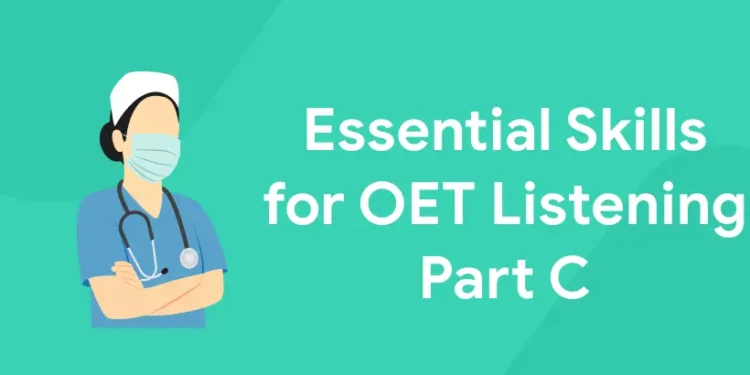Table of Contents
In OET Listening Part C, you will hear two recordings that are either interviews or presentations including at least one healthcare expert. The audios in Part C are comparable to what you would hear at a professional development session. In this blog post, we’ll look at the format of the OET Listening Part C, the skills examined, and some test tips and advice for Part C preparation.
Get your Desired OET Scores in Weeks! Get a Free Demo Class Here!
OET Listening Part C Format
Here is an overview of the OET Listening Part C format.
- Two audio recordings
- Presentation or interview
- Professional development-type audios
- 4-5 minutes each
- Six 3-option multiple-choice questions per audio
- 90 seconds to prepare
Two recordings, consisting of presentations or interviews with healthcare professionals, are heard in OET Listening Part C. The audios in Part C are comparable to what you would hear at a professional development session. Examples include workplace presentations, personal stories of case studies or projects, research presentations or discussions, and case studies or reviews.
There are six 3-option, multiple-choice questions in each recording, which lasts for about four to five minutes. You have ninety seconds to read the questions and answer choices before the audio starts.
Tips for OET Listening Part C
Candidates often report that OET listening section C is the hardest listening section on the test. It has the same multiple-choice format as OET hearing part B, but the texts are longer—typically spanning six to seven minutes—in contrast to part B. It can be difficult to focus during long recordings like this one, especially when there is only one main speaker and a lot of material can be covered quickly. Therefore, here are four essential tips on how to ace OET listening part C to increase your chances of receiving a high score on this task.
Begin with a top-down strategy
A top-down method is one in which we approach a fresh text by utilising our own past knowledge about the subject matter. As a result, we would approach a documentary about the Zika virus with preconceived ideas and expectations if we were about to listen to a radio program about the virus in our native tongue. We may compare the Zika virus to other viruses we are aware of, as well as think about the virus’s origin, symptoms, and ways to avoid getting it. These ideas all prime us to pay attention to a long text.
When we listen, we make logical assumptions that help us understand new information more quickly. To aid in our understanding, we can approach an OET hearing part C text in a similar manner to how we would approach a piece of this nature in our own tongue. It is always clear from the first sentence who is speaking and what the topic of the text is.
Follow the suggestions given in the interview questions
OET listening portion C has two extracts. These will either be in the form of a single-speaker presentation or a two-speaker interview. In an interview, this can be useful as each question the interviewer asks should remind the subject that he or she needs to focus on a different question from the question paper.
Watch out for signposting language
If you are listening to the presentation instead of the interview, you will need to use caution when choosing your signposting language. Longer speech segments can be structured by use signposting language, which indicates the start of a new idea and the end of an existing one.
Discourse markers such as “Now” and “Thus” or adverbs such as “first,” “second,” and so on can be used to indicate a change in topic or the development of an idea.
Watch presentations and interviews online
There is a plenty of English-language content accessible to help you prepare for the content covered in OET listening section C. Because you can only access the audio, podcasts are highly helpful because they lack pictures, much like the OET listening exam.
BBC podcasts feature a range of interviews and in-depth monologues. Some podcasts, such as Sam Harris’ Making Sense, have lengthy interviews and speeches with a range of accents and signposting language examples.
Listen to this type of content on a regular basis, and then try to condense what you heard and learnt into a few phrases. This is a great way to prepare for OET part C and receive more exposure to the English language.
Enroll in our OET preparation course and achieve your desired score.
Skills for OET Listening Part C
1: What is the primary purpose of a patient’s discharge summary?
Your ability to listen to lengthy talks and presentations on healthcare-related subjects, as well as to comprehend how others present arguments, discuss research, examine case studies, and other subjects that will be important to your continued professional development, will all improve as you get ready for Listening Part C.
The following are some essential skills to practise for Part C
Get proficient with unfamiliar content
You never know what subjects will be covered in Part C on test day. Since the audio will have all the information you require, you do not need to be an expert on the subject. To assist you grow confident and at ease listening to in-depth talks or presentations on subjects outside of your area of expertise, it’s a good idea to listen to a wide range of topics.
Develop your stamina
It requires focus and effort to listen to lengthy audios. To practise listening for extended periods of time without becoming distracted, try listening to podcasts, TED speeches, and presentations. You can begin with one minute and gradually increase it.
Expand your language skills
Make sure you keep adding new languages to your repertoire. Part C may require you to identify the motivations behind someone’s actions, their feelings, and the opinions of others. Which phrases convey agreement, disagreement, worry, or scepticism do you know? In what ways could speakers advise, caution, discourage, or suggest? Are there various methods to communicate reason, cause, and effect? Knowing all of this language is beneficial. Look through the Part C transcripts to find every word and expression style used by speakers to convey these concepts.
Practice summarising while you listen
A lot of part C questions assess your ability to comprehend gist, or to make sense of a lengthy speech segment that may consist of two, three, or four phrases. Before the test, you can practise this by listening to brief excerpts from tests or podcasts and then summarising what you heard in one line. After that, play the transcript again to make sure you understood.
Entri App – Online OET Coaching
Do you plan to pass the OET exam on your first attempt? Are you looking for a study guide that will allow you to train for a short period of time and achieve the necessary OET score? The knowledgeable instructors at Entri will use individualised, rigorous, and deliberate learning strategies to help you enhance your OET results.
Course Overview
The purpose of the OET Preparation Course on the Entri App is to help healthcare professionals meet the requirements of the Occupational English Test (OET) by helping them to improve their English language proficiency. This comprehensive course covers all four language skills—Listening, Reading, Writing, and Speaking—in great detail, with a focus on the context of healthcare settings to ensure that students are prepared to satisfy the OET criteria.
Get your Desired OET Scores in Weeks! Get a Free Demo Class Here!
Crack OET & Boost Your Healthcare Career!
OET Coaching by Entri App: Get expert guidance, practice with real exam scenarios, and achieve your target score to advance your healthcare career.
Join Now!Frequently Asked Questions
How are marks for the Listening sub-test distributed?
The Listening subtest has 42 possible marks in total. Part C is worth 12 marks, Part B is worth 6 marks, and Part A is worth 24 marks.
Can I retake OET listening only?
You can retake the OET test, and if you pass the second time around on the subtest, you can combine the results of the two OET tests and submit an application for registration.
Is OET hard to pass?
The OET exam is thought to be an easy test.










